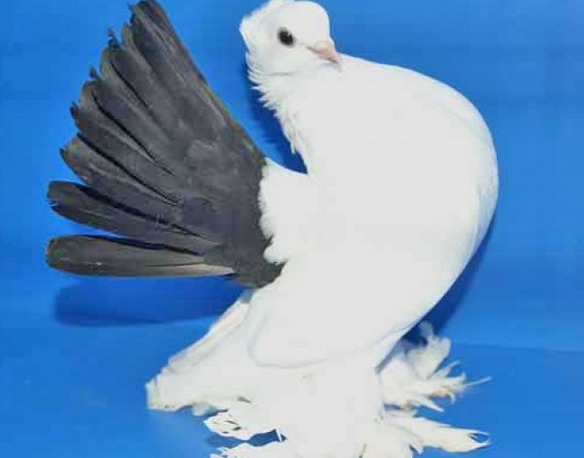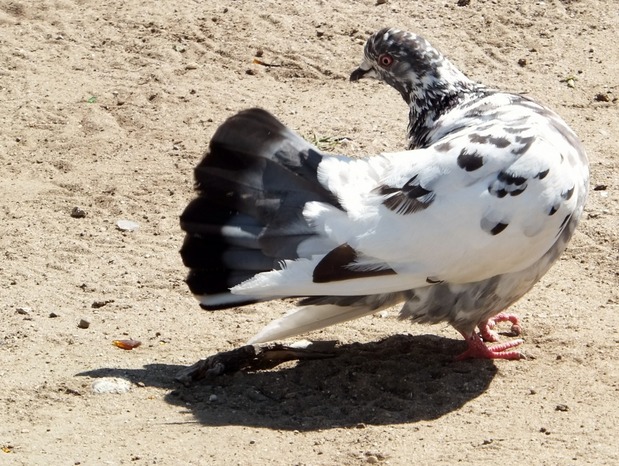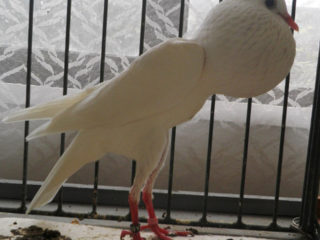Content
Stately pigeons appeared in the Don and Kuban villages. For a long time, birds were bred in the Volga and Siberian lands. Unique varieties of stately ones have been created in Ukraine and the Urals. They all have common characteristics and at the same time differ in their characteristic behavior, proportions, physique, and feather color.
Characteristics of stately breeds
The name of these birds speaks for itself. They are called stately for their beautiful appearance - a proudly raised head, a slightly protruded chest and a wide tail raised up. The wings hang down a little, sometimes even touching the ground. Pigeon breeds are named after the place of breeding, the city or region where they first appeared. They are combined into groups based on features inherent in appearance and flight patterns.
Having seen stately pigeons at least once, it is impossible to remain indifferent; they captivate with their majestic appearance and the beauty of their plumage.The name of the group “stately” appeared not so long ago, in 1982. The desire to unite under a common name various similar breeds, distinguished by their special beauty of posture, first arose among Moscow pigeon breeders. Annual exhibitions and competitions are a joy and holiday for bird lovers. They say that in the USSR, cars and apartments were given for a pair of stately pigeons.
When evaluating birds at an exhibition, they determine their breed, which depends on the proportionality of their build. Lastly, the beauty of the feather design is assessed. The color of the eyes is important; usually in dark birds it is light, pearly, and in snow-white and light birds it is black.
The character of stately birds is calm and good-natured; aggressive individuals are rare. When breeding new breeds, preference is given to characteristic appearance over flight quality.
Classification of stately pigeons
Characteristic traits were formed by breeders through genetic selection and the consolidation of qualities that seemed attractive. Pigeon breeders have grouped pigeons into different groups based on their appearance and ability to fly. Several different breeds can belong to one group. There are many stately mixed-breed pigeons that have disadvantages, so it is better for novice pigeon breeders to buy birds from trusted breeders. At bird shows, the smallest details of the feathered winners play a role - the position of the head and tail, shape, size, color of the beak and feathers, eye color, walking movements. The reason for disqualification may be too long paws, large or, conversely, small body size, etc.
According to the shape and position of body parts
Among the stately breeds, those whose wings are lowered almost to the ground are distinguished. Such birds are called lop-winged birds.They are larger than other varieties and do not stick out their chest like a wheel so much. These breeds include the following pigeons.
- Dubovsky
- Martynovsky
- Kamyshensky
- Rzhevsky and others
Another subgroup of stately ones - shakers, unites small and medium-sized birds with a shortened body and a beautifully curved neck. They stick their chest out with the wheel forward. When excited they shake their heads, which is why they are called shakers. These breeds belong to them.
- Lugansk white stately
- Volga Stately Red-breasted
- Yeisk stately double-toothed
- Poltava stately black-tailed
- Uryupinsky stately blue
- Voronezh beetles
- Stately Kazan
Rockers not only shake their heads, but also sway as they move back and forth on the ground. They also have a short body, a curved neck and a strongly protruded chest. This group includes Novocherkassk black-tailed and others.
According to flight qualities
The leisurely circular flight of Russian stately pigeons can be observed for hours. The hardiest birds spend up to 6 hours a day in the sky. Not all breeds have the same ability to fly; on this basis, three groups of pigeons are distinguished:
- decorative ones that don’t really like to fly;
- Turmans, who can somersault in flight;
- high-flying sky lovers.
At bird exhibitions, competitions are held on the duration and beauty of flight, and the ability of birds to return to the roof of their dovecote. Decorative breeds do not participate in such competitions. Pigeon breeders train high-flying and tumbler pigeons in advance, letting them fly every day.
By plumage color
The color of stately pigeons is varied. Depending on the feather pattern, such groups of birds are distinguished.
- Colour-sided
- Variegated
- Color-breasted
- Color-tailed
- Plain
Sometimes monochromatic birds are called doper birds. Among the multi-colored suits, the most common are colored breasts. Their color pattern is similar to that of a magpie - white body, dark head, neck, chest and tail. There are breeds with a white ribbon in the tail. Speckled stately pigeons are called curly pigeons.
Flight of stately breeds of pigeons
The flight of tumblers is especially interesting. They can perform incredible feats in the air, flipping and tumbling over their tail or wing. In addition to hereditary data and breed characteristics, systematic training is important for good results.
Pigeon breeders try not to allow representatives of particularly valuable breeds to roam freely, limiting their freedom to enclosures. Not only people, but also predatory hawks hunt for beautiful birds. The calm comes only in the summer, when predators are busy breeding their own offspring.
Breeds of stately pigeons with photographs and names
In recent years, there have been more pigeon breeders involved in stately pigeons than at the beginning of the 2000s. This is due to the emergence of organized clubs that help novice fanciers not only buy good, thoroughbred birds, but also raise them healthy. Since the end of the last century, many new breeds of stately pigeons have appeared in Russia. They have repeatedly won prizes at prestigious exhibitions.
Rostov stately pigeons
The breed was developed about 100 years ago.The regal appearance of the birds will not allow them to be confused with other representatives of the pigeon brotherhood. The plumage is characterized by a two-color color - black head, back, tail and wings, white neck, chest and belly.
Description of birds:
- two-tone white and black color;
- drooping wings;
- protruding chest;
- fan tail;
- pearly eye color;
- feathered legs with spurs;
- small beak of matte color;
- a forelock grows on the head at the nape.
Rostov pigeons are decorative flying birds. The main color of the feathers on the upper body can be not only black, but also yellow and red.
Stately pigeons of Chernovalov
Sometimes breeds are named after the pigeon breeder who created them. This happened with Chernovalov’s pigeons. The birds have a solid white color, feathers that fit tightly to the body, and a high tail in the form of a dense fan. A distinctive feature is the long feathers on the legs. The breed can be classified as a shaker - when excited, they amusingly shake their heads and coo. You can appreciate the beauty of the stately pigeons in the video below.
Voronezh stately pigeons
There are several stately breeds bred in the Voronezh region. Voronezh beetles, created on the basis of stately decorative pigeons, are especially popular. They first appeared in the 70s of the twentieth century.
Short description:
- paws shortened, densely feathered;
- harmonious physique;
- fan tail;
- the head is smooth;
- small straight beak;
- arched neck and wide chest;
- drooping wings.
Feathers that fit tightly to the body. Color black, pearl eyes. The breed continues to develop; in recent years, individuals with different plumage colors have appeared.
Lugansk stately pigeons
A very beautiful breed, they like to use it at weddings and special events, releasing the birds into the air at the climax.
Description of birds:
- white feathers;
- pinkish beak;
- black or dark cherry eyes;
- drooping wings;
- head without feather decoration;
- on small paws there are feathers up to 6 cm long.
The breed is classified as a subgroup of shakers; pigeons make characteristic head movements when excited.
Volga stately pigeons
There are several breeds bred in the Volga region. The most famous are the stately ribbon pigeons. Distinctive features of the breed: beautiful feather coloring and good flying abilities. The birds have feather decoration on their legs, and a white border runs along the edge of the tail. The main color of the body is red, only the wings, belly, throat and cheeks, feathers on the legs and the ribbon on the tail are white.
Yeisk stately pigeons
This breed belongs to the group of shakers. Birds have two forelocks - one in front of the beak, and the second on the back of the head. The birds are distinguished by their strong constitution, fertility and bright temperament. The breed appeared at the beginning of the twentieth century, in the city of Yeisk; Rostov stately pigeons were used to breed it.
Short description:
- body size is average;
- oval head with two forelocks;
- the beak is light, straight and thickened, about 1.5 cm long;
- arched neck of medium length;
- the body is short and wide;
- wings hanging from the tail;
- the tail is fan-shaped and has more than 12 feathers.
Slightly ruffled plumage, loosely fitting to the body, can be of various colors. Eye color depends on the feather color; it is dark in white birds and light in black birds.
Beloglinsky stately pigeons
In the village of Belaya Glina, stately pigeons enjoyed special honor and attention in the middle of the last century. The Cossacks brought the founders of the breed from Ukraine. Over many years of targeted selection, birds have been crossed with many similar breeds. The result was individuals with a beautiful combination of body shape and regal posture.
Description of the Beloglinsky stately:
- shortened bare paws;
- fan-shaped tail;
- slightly curved small beak;
- neck curved behind the back;
- small and wide body.
A variety of feather colors are acceptable. The beautiful white-tailed variety has a colored body and white tail feathers. The stately Beloglinskys fly well and can do somersaults in the air.
Starominsky stately pigeons
A small variety, it was bred in the Starominsky district of the Krasnodar Territory. The color of the feathers is varied. A distinctive feature of the breed: the structure of the head (wide forehead, tuft at the back of the head). Characterized by unusual behavior - when excited, the pigeon leans back and sits on its tail. The bird has feathers on its legs, its chest is beautifully curved like a wheel, and its raised and fanned tail has about 16 feathers.
Breeding stately pigeons
For breeding and keeping pigeons, wooden or brick dovecotes are built, and sometimes the attics of multi-story buildings are used. The room should be spacious and bright, with good ventilation. Next to the dovecote, an aviary is being built for purebred birds, which are not allowed to fly, but are kept to produce offspring. Most pigeons have the opportunity to fly freely into the sky; they always return to their native dovecote.
1 square meter is allocated for one couple. m of area in the summer enclosure.Placing birds too densely can lead to various diseases and fights for territory. Pigeons live in permanent pairs; infidelity in bird families is an exception to the rule.
In the dovecote, perches and nest boxes are installed near the walls. They are similar to multi-tiered shelves with compartments of the same size. During the breeding season, birds are switched to three meals a day. The male and female take turns incubating the eggs. They also feed the chicks together.
The female lays no more than 2 eggs and incubates the chicks for 18 days. Baby pigeons are born helpless and ugly, but already in one and a half months they acquire the beauty of their parents. Over the course of a year, a female can lay and hatch eggs several times. On the first day, she feeds the chicks with “bird milk” - special mucus from the crop, then gives the babies semi-digested grain. Pigeons begin to eat food on their own at the age of one month, sometimes a little later.
Water for birds, especially young ones, is changed 2 times a day, and the room is kept clean. Experienced pigeon breeders use special drinkers with a dome-shaped top to prevent droppings from falling into the water when the birds land on top.
Pigeons are ringed: in odd years, on the left leg, in even years, on the right leg. The rings indicate information about the country and time of birth, membership in a particular club. Without a ring, a pigeon will not be taken to the exhibition. If the bird gets lost, the information that can be read on the foot will help locate the owner.
Pigeons are fed most often 2 times a day - morning and evening. The amount of grain required for one individual depends on the breed and size - from 30 to 50 g per day.
Feed composition:
- wheat;
- corn;
- unpeeled peas;
- Vika;
- millet;
- seeds;
- corn.
Grain mixtures are used for feeding. They may contain more than a dozen types of grain crops. The main grain that Russian pigeon breeders use in the diet of pigeons is wheat. Vetch is fed only from the age of 2 years. Be sure to provide mineral supplements intended for pigeons, with clay, flaxseed, sand, salt, eggshells, shell rock and other components.
Disease prevention consists of vaccinations, twice a year. To strengthen the immune system, be sure to give vitamins. The first vaccination of chicks is carried out at about a month. During molting, birds are always weakened and need special attention and care.
Conclusion
Stately pigeons are incredibly beautiful. All breeds of these stately birds are similar to each other, but have their own distinctive characteristics. To successfully breed birds, two things are needed - love for them and a good dovecote. Pigeons are unpretentious in their care, breed their own offspring, and form monogamous pairs for life. For maintenance and breeding, you need a spacious dovecote with perches, nest boxes, drinkers and feeders.


































